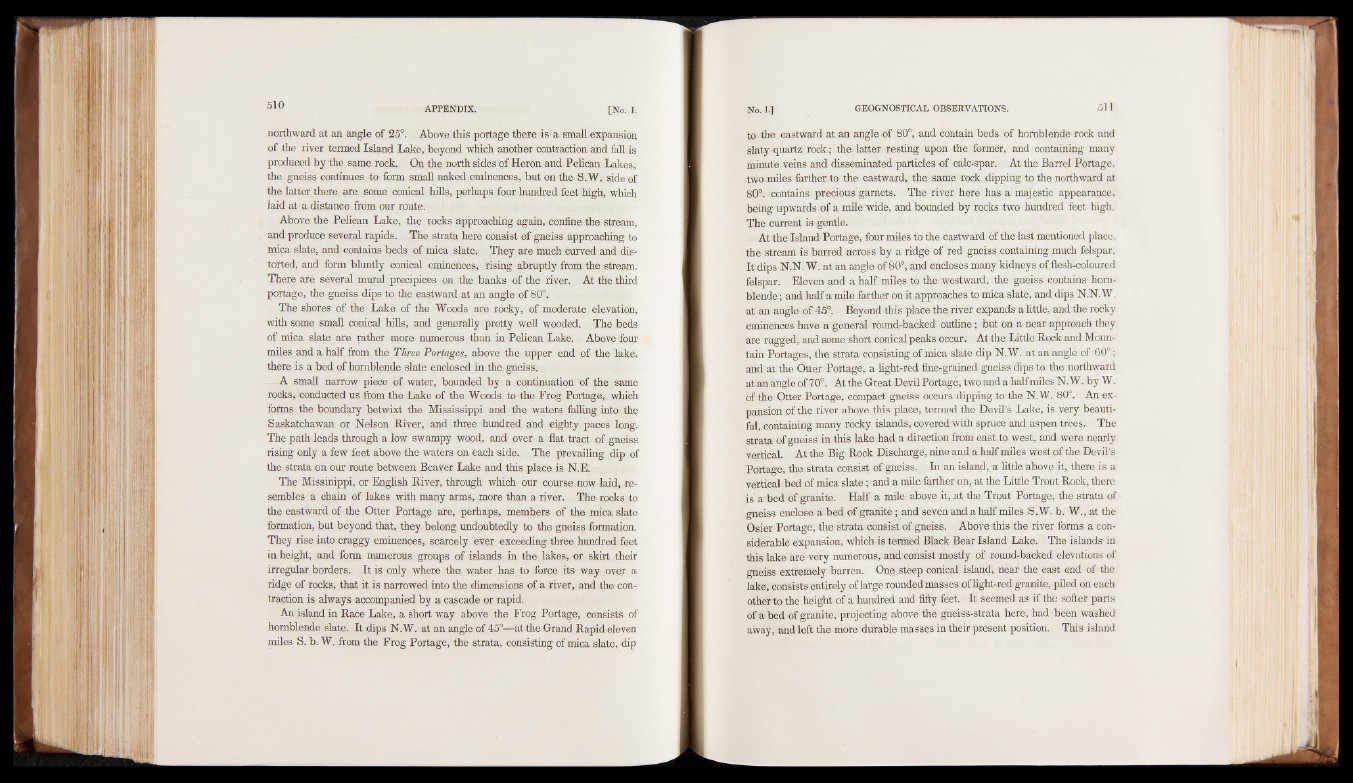
northward at an angle of 25°. Above this portage there is a small expansion
of the river termed Island Lake, beyond which another contraction and fall is
produced by the same rock. On the north sides of Heron and Pelican Lakes;
the gneiss continues to form small naked eminences, but on the S.W. side of
the latter there are some conical hills, perhaps four hundred feet high, which
laid at a distance from our route.
Above the Pelican Lake, the rocks approaching again, confine the stream,
and produce several rapids. The strata here consist of gneiss approaching to
mica slate, and contains beds of mica slate. They are much curved and distorted,
and form bluntly conical eminences, rising abruptly from the stream.
There are several mural precipices on the banks of the river. At the third
portage, the gneiss dips to the eastward at an angle of 80°.
The shores of the Lake of the Woods are rocky, of moderate elevation,
with some small conical hills, and generally pretty well wooded. The beds
of mica slate are rather more numerous than in Pelican Lake. Above four
miles and a half from the Three Portages, above the upper end of the lake,
there is a bed of hornblende slate enclosed in the gneiss.
A small narrow piece of water, bounded by a continuation of the same
rocks, conducted us from the Lake of the Woods to the Prog Portage, which
forms the boundary betwixt the Mississippi and the waters falling into the
Saskatchawan or Nelson River, and three hundred and eighty paces long.
The path leads through a low swampy wood, and over a flat tract of gneiss
rising only a few feet above the waters on each side. The prevailing dip of
the strata on our route between Beaver Lake and this place is N.E.
The Missinippi, or English River, through which our course now laid, resembles
a chain of lakes with many arms, more than a river. The rocks to
the eastward of the Otter Portage are, perhaps, members of the mica slate
formation, but beyond that, they belong undoubtedly to the gneiss formation.
They rise into craggy eminences, scarcely ever exceeding three hundred feet
in height, and form numerous groups of islands in the lakes, or skirt their
irregular borders. It is only where the water has to force its way over a
ridge of rocks, that it is narrowed into the dimensions of a river, and the contraction
is always accompanied by a cascade or rapid.
An island in Race Lake, a short way above the Frog Portage, consists of
hornblende slate. It dips N.W. at an angle of 45°—at the Grand Rapid eleven
miles S. b. W. from the Frog Portage, the strata, consisting of mica slate, dip
to the eastward at an angle of 80°, and contain beds of hornblende rock and
slaty quartz rock; the latter resting upon the former, and containing many
minute veins and disseminated particles of calc-spar. At the Barrel Portage,
two miles farther to the eastward, the same rock dipping to the northward at
80°. contains precious garnets. The river here has a majestic appearance,
being upwards of a mile wide, and bounded by rocks two hundred feet high.
The current is gentle.
At the Island Portage, four miles to the eastward of the last mentioned place,
the stream is barred across by a ridge of red gneiss containing much felspar.
It dips N.N. W. at an angle of 80°, and encloses many kidneys of flesh-coloured
felspar. Eleven and a half miles to the westward, the gneiss contains hornblende
; and half a mile farther on it approaches to mica slate, and dips N.N. W.
at an angle of 45°. Beyond this place the river expands a little, and the rocky
eminences have a general round-backed outline ; but on a near approach they
are rugged, and some short conical peaks occur. At the Little Rock and Mountain
Portages, the strata consisting of mica slate dip N.W. at an angle of 60° ;
and at the Otter Portage, a light-red fine-grained gneiss dips to the northward
at an angle of 70°. At the Great Devil Portage, two and a half miles N.W. by W.
of the Otter Portage, compact gneiss occurs dipping to the N.W. 80 . An expansion
of the river ahove this place, termed the Devil’s Lake, is very beautiful,
Containing many rocky islands, covered with spruce and aspen trees. The
strata of gneiss in this lake had a direction from east to west, and were nearly
vertical. At the Big Rock Discharge, nine and a half miles west of the Devil’s
Portage, the strata consist of gneiss. In an island, a little above it,; there is a
vertical bed of mica slate ; and a mile farther on, at the Little Trout Rock, there
is a bed df granite. Half a mile above it, at the Trout Portage, the strata of
gneiss enclose a bed of granite ; and seven and a half miles S.W. b. W., at the
Osier Portage, the strata consist of gneiss. Above this the river forms a considerable
expansion, which is termed Black Bear Island Lake. The islands in
this lake are very numerous, and consist mostly of round-backed elevations of
gneiss extremely barren. One steep conical island, near the east end of the
lake, consists entirely of large rounded masses of light-red granite, piled on each
other to the height of a hundred and fifty feet. It seemed as if the softer parts
of a bed of granite, projecting above the gneiss-strata here, had been washed
away, and left the more durable masses in their present position. This island